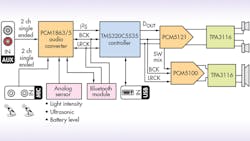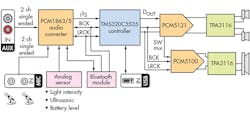Every December, Electronic Design presents its big review of new analog products introduced during the past year. However, analog-semiconductor manufacturers announce new products every week, so it also makes sense to do a recap on a quarterly basis. The following analog ICs were unveiled by Linear Technology, Texas Instruments, Analog Devices, and Maxim Integrated products from January to the end of March.
Linear Technology
In mid-March, Linear Technology announced the LT6023, a low-power, enhanced slew rate, precision operational amplifier. It uses a proprietary input stage that allows the output to quickly slew to within 0.0015% of its final value, even when applying large signal input steps.
Specifically, by configuring the LT6023 in unity gain and applying a 10-V step to the input, an output will slew at 1.45 V/μs, a 5-V input step will slew the output at 0.65 V/μs, and a 0.7-V input step lowers the slew rate to 0.02 V/μs. Linear says achieving these slew rates presented a challenge while maintaining optimum input offset voltage, common-mode rejection, and noise.
One target application is a multiplexer, which often experiences large input voltage transitions as the input cycles between input sources. The bipolar amplifiers customarily used in these devices employ back-to-back diodes between the inputs (according to Linear’s datasheet). These turn on when the input transient voltage exceeds 0.7 V.
With standard op amps, this results in a large transient current, which is then conducted from the amplifier output stage back into the input-driving circuitry. Every time it occurs, the driving circuitry must absorb this current and settle before the amplifier can settle. To solve the problem in the LT6023, Linear used 5.5-V Zener diodes. A number of other interesting design innovations are detailed in the part’s datasheet.
This file type includes high resolution graphics and schematics when applicable.
A week or so earlier, Linear announced the LTC6752 family of very-high-speed comparators for high-frequency line drivers and clock-recovery circuits. “High speed” means they can support toggle rates up to 280 MHz, thanks to propagation delays as low as 2.9 ns and rise and fall times on the order of 1.2 ns. The five family members include options for separate input and output supplies, shutdown, output latch, adjustable hysteresis, complementary outputs, and package configurations.
Rail-to-rail inputs operate from 2.45, 3.5, or 5.25 V, depending on the option. Outputs are CMOS and the separate supply options can operate down to 1.71 V, allowing for direct interfacing to 1.8V logic. Other key specs, such as 1.8-ns overdrive variation (10 to 125 mV) and 4.5-ps jitter, make these comparators an excellent choice for critical timing applications.
February was a particularly big month for new analog arrivals from Linear (the company challenges its engineers to release one new product a week, across all its product lines). These include the LTC5564H, a 7-ns response time, 15-GHz RF detector with fast comparator; the LTC2875, a pair of 3.3- and 5-V, 4-Mb/s, CAN-bus transceivers that can handle ±60-V voltage strikes while operating at temperatures up to 25° C, and the LTC22373, an 18-bit, 1-Msample/s, 8-channel, multiplexed SAR ADC with a signal-to-noise-ratio of 100 dB.
Speaking of analog in general, and Linear Technology in particular, the company published the final volume of its “Analog Circuit Design” series of hardcover books. The series started with two volumes of applications notes created by the late Jim Williams. The first two volumes are titled A Tutorial Guide to Applications and Solutions and Analog Circuit Design and Immersion in the Black Art of Analog Design. Volume 3, the Design Note Collection, comprises all of the design notes published as tip-ins over several decades. It constitutes an amazing resource, with contributions not only from Jim, but from Bob Dobkin, George Erdi and Carl Nelson as well.
The books are the books are available at the Elsevier Store and on ScienceDirect.com, Elsevier's full-text scientific database.
Texas Instruments
Analog products unveiled by TI in Q1 include the PCM1865 family of six high-performance audio ADCs (see the figure). They combine features typically found in portable audio codecs, with performance specifications found only in single-function, professional audio ADCs. The devices require only a single 3.3-V supply. This eliminates the need for a dedicated analog 5-V rail, opening the door to smaller, more efficient products. Targeted applications range from personal computers, sound bars, and audio docks to Bluetooth speakers, video-security systems, and automotive infotainment systems.
The six pin-to-pin compatible devices in the family have two- and four-channel options, with software- and hardware-controlled variants. Three of the devices can achieve up to 110-dB dynamic range, unheard of with only a single 3.3-V power supply. With direct, high-voltage 2.1-VRMS support, the devices optimize audio quality and allow for a higher signal-to-noise ratio (SNR). Software-controlled clipping-suppression helps optimize input sensitivity for maximum SNR.
The devices integrate a clock-generating phase-locked loop (PLL), programmable gain amplifier, and universal front end that supports various inputs from low-level microphones to 4.2-VRMS differential inputs.
Unique to TI is proprietary “Energysense” technology—it helps designers meet operating requirements set by the European Union’s (EU) Ecodesign Directive. In other words, according to TI, it’s simple to set both sleep and wake-up thresholds, which can help equipment achieve the energy-efficiency levels required in the EU directive.
Analog Devices
ADI announced all of its pure analog devices for the quarter on February 15. Leading the way was the AD9154, a quad-channel, 2.4-Gsample/s, 16-bit digital-to-analog converter (DAC) with dynamic-range performance in the 100- to 300-MHz band for complex IF transmitters. In a different twist, the device incorporates an AD9154 quad, 16-bit DAC; an on-chip PLL; and an eight-lane JESD204B interface.
With that combination of features, a single device can be employed to meet all requirements in multicarrier GSM and LTE transmitters in a range of applications, such as wireless macro base stations, point-to-point microwave radios, military radios, and radio test equipment. The DACs offer a range of features for advanced IF transmit applications, too, including complex digital modulation; input-signal power detection; and gain, phase, and offset compensation.
That same day, Analog Devices introduced a new ADC/DAC/GPIO combination IC that gives designers a new level of flexibility in handling system monitoring and control: the completely user-configurable 12-bit, 8-channel AD5592R. It includes a 400-ksample/s ADC, 6-μs settling-time DAC digital inputs and outputs, and a reference on a single chip. It can be user-configured in any combination of up to eight devices, making it possible to use a single IC to complete multiple system monitoring and control functions.
Maxim Integrated
In February, Maxim Integrated demonstrated its MAX11300 “programmable analog family of devices for industrial control and automation, the IoT, base-station RF controllers, and power-supply monitoring.” The device offers 20 mixed-signal high-voltage, bipolar ports, which are configurable as an ADC analog input, a DAC analog output, a general-purpose input port (GPI), a general-purpose output port (GPO), or an analog switch terminal. One internal and two external temperature sensors track junction and environmental temperature, respectively. Adjacent pairs of ports are configurable as a logic-level translator for open-drain devices or an analog switch.
Thanks to the mixed-signal PIXI I/O, the device essentially “brings programmability to high-integration analog applications.” According to Maxim, it’s “the industry’s first configurable, 20-channel, –10- to +10-V high-voltage mixed-signal IC.” PIXI ports provide highly flexible hardware configuration for 12-bit mixed-signal applications. The MAX11300 is best suited for applications that demand a mixture of several analog and digital functions. Each port is individually configurable with up to four selectable voltage ranges within –10 to +10 V.
The device allows for the averaging of 2, 4, 8, 16, 32, 64, or 128 ADC samples from each ADC-configured port. A DAC-configured output port can drive up to 25 mA. The GPIO ports can be programmed to user-defined logic levels, and a GPI coupled with a GPO forms a logic-level translator.
Internal and external temperature measurements are able to monitor user-programmable conditions of minimum and maximum temperature limits, using the interrupt to notify the host when there’s an occurrence of one or more conditions. Temperature measurement results are made available through the serial interface.
On a more fundamental level, there is an internal, low-noise 2.5-V voltage reference. However, it’s also possible to use external voltage references with separate inputs for the DAC and ADC. For I/O, a four-wire, 20-MHz, SPI-compatible serial interface handles communication with the host.
On another front, Maxim says it has the industry’s only 1.8-V-capable isolators—the MAX14930, MAX14931/MAX14932, MAX14934, MAX14935, and MAX14936—that can deliver up to 30% better propagation delay and up to 50% lower pulse width distortion than competitors. Where needed, ultra-robust, 5-kVRMS, four-channel digital isolators transfer digital signals between circuits with different power and ground domains, and where noise isolation, ground loop mitigation, and/or safety are of concern.
What Does it All Mean?
Not surprisingly, most of these new products target specific kinds of applications. Even when it comes down to something as basic as a successive-approximation analog-to-digital converter, one size no longer “fits all.” Consider something like noise. There are really a number of environmental circumstances that fall under the heading of “noise,” and they affect signal integrity differently.
For example, making even a simple amplifier or data converter optimally immune to noise problems from the external environment, from its power supply, and from what other nearby chips are doing, is a systems engineering problem. Rather than trying to tweak a design composed of generic devices after a prototype is built, it seems better to tackle it with a set of complementary chips already designed to work together in specific applications environments. The range of new products described in this article and the way they were crafted for specific applications (or, to be fair, for ranges of similar applications) illustrates the kind of teamwork that must go on between product designer and semiconductor designer.
This file type includes high resolution graphics and schematics when applicable.
About the Author

Don Tuite
Don Tuite (retired) writes about Analog and Power issues for Electronic Design’s magazine and website. He has a BSEE and an M.S in Technical Communication, and has worked for companies in aerospace, broadcasting, test equipment, semiconductors, publishing, and media relations, focusing on developing insights that link technology, business, and communications. Don is also a ham radio operator (NR7X), private pilot, and motorcycle rider, and he’s not half bad on the 5-string banjo.


